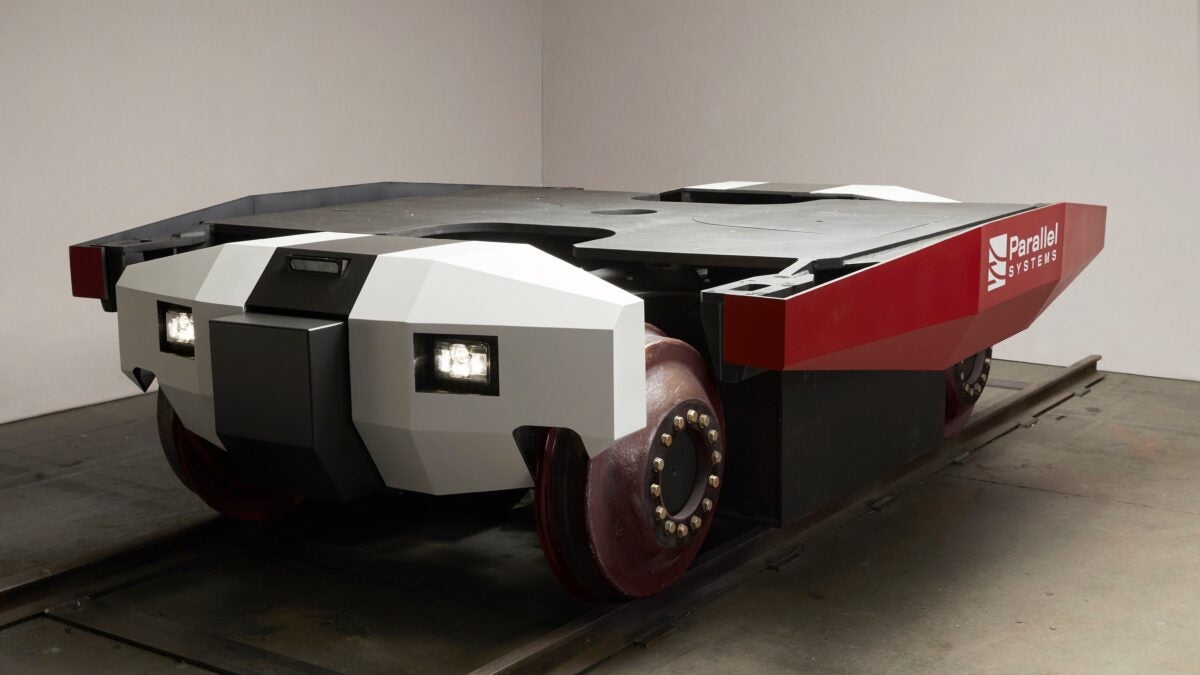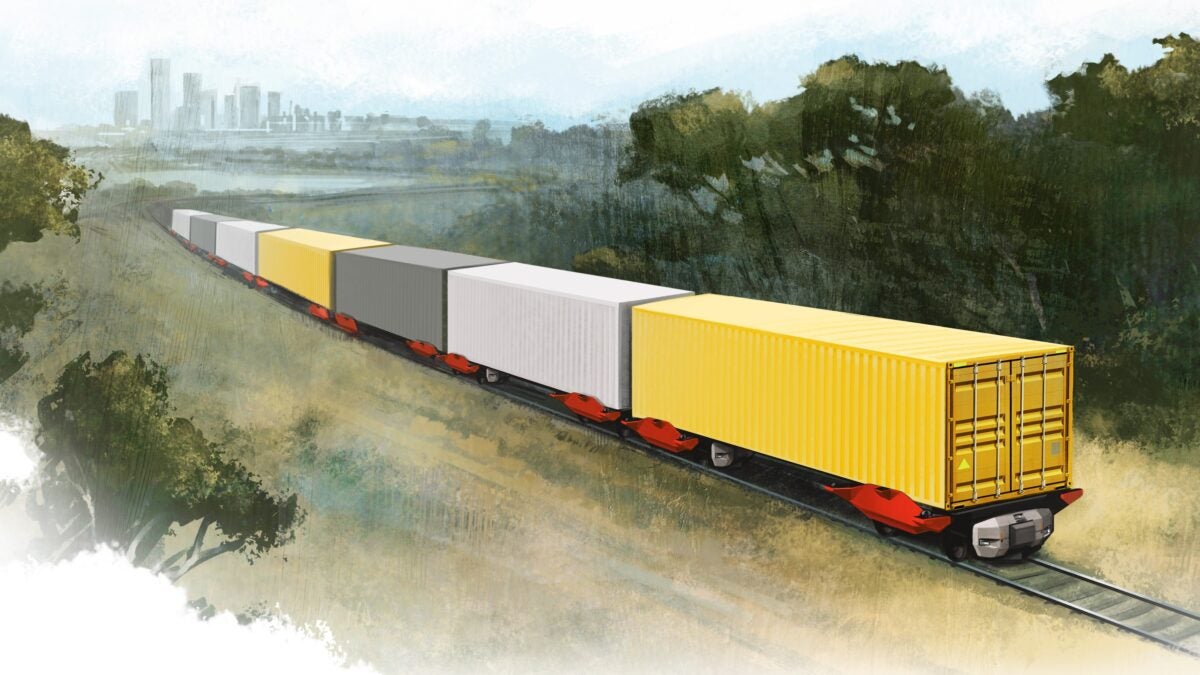Bolstered by a $49.55 million series A funding round it completed in January, autonomous battery-electric rail vehicles company Parallel Systems aims to reduce emissions by making rail transportation more efficient and competitive and moving freight from roads to rails.
The Culver City, California-based company is testing an autonomous rail system that includes two battery-electric rail vehicles that can attach to different-sized intermodal containers and move containers individually or in a “platoon.”
Read: Autonomous battery-electric rail company closes series A funding round
Matt Soule, co-founder and CEO at Parallel Systems, told FreightWaves more about the company’s goals and how it plans to use the funding.
The interview has been edited for clarity and length.
FREIGHTWAVES: What rail challenges are Parallel Systems trying to solve?
SOULE: “It’s actually more aerodynamic than individual trucks on the road, but the challenge for rail is it needs to work at large scale to get the right economics. There’s a lot of the market that they’re not able to address because of those limitations.
“So we were looking at how do we preserve the energy efficiency of rail but allow rail to address new markets? If you’re doing intermodal, you have to be cost competitive with trucks. That’s the reality of transportation. Rail generally enjoys an economic advantage over trucks, and it’s cheaper, but the quality of service is not as high.
“That’s what our technology is trying to address. This is not a replacement for trains. This is an augmentation of rail services to be able to do lower-volume, shorter-haul trains that are still cost competitive with trucks, and at the same time, allow them to improve some of the quality of service.”
FREIGHTWAVES: How do these autonomous battery-electric rail vehicles work?
SOULE: “Every bogie has a traction motor and a battery, so they’re self-propelled. The reason there’s two of them is because we are looking at further aerodynamic improvements. Because there’s different-sized intermodal containers, we wanted to be agnostic to the size of the container. We let the container define the length of the car.

“Each bogie also has computers and radios and sensors to give it telematics, to give it an ability to coordinate with other vehicles, but also to interface to railroad back-office systems that coordinate activity, just like a normal freight train would be on the network.
“We’re requesting track authority through these back-office systems with the railroads, and that’s a key principle for rail operations and safety — that central coordination. One of the challenges has been understanding the back-office system of major railroads. We’re working with experts on that right now.”
FREIGHTWAVES: How do the vehicles move together in platoons?
SOULE: “It’s a bumper system. Much like any other railcar has draft gear, it’s a spring damper system attached to the couplers that’s able to absorb the forces that are being transmitted through the car.
“When they’re moving together in a platoon, they aren’t coupled magnetically or mechanically. They’re simply pushing from the rear to keep those bumpers in contact with each other. There are sensors in the bumper that allow us to control the overall opportunity formation of them.
“The reason you move in a platoon is because this is one of the energy benefits of rail. Even though you have a square end of a container, because we are grouping them together with very small air gaps, the average drag over the entire platoon — each vehicle’s work it has to do — is much lower.
“Whereas if you get a single container, it would not be as energy efficient because it’s not aerodynamic. But, when you move them together, you get aerodynamic benefits. It’s also just not a smart use of track capacity to move single vehicles at a time.

“Our platoon size would range between 10 and 50 cars — 50 cars would be about 2,500 feet long. So, quite a bit shorter than some of the intermodal freight trains that are being constructed today, but still large enough to not make a significant trade-off in rail operations. We can do double stacking too.”
FREIGHTWAVES: What does Parallel Systems plan to do with the $49.55 million in funding?
SOULE: “We have been building our second-generation vehicles, and these are vehicles we’ll be using for some advanced testing programs to really assess, verify and validate some of these key operating principles, as well as the autonomy system. That capital is going to be going to build those vehicles, but it’s also going to be going to expanding our team.
“We’re looking to hire about 60 engineers, most of them in software, to really build the core software for this product. As much as this looks like a hardware project, much of it is actually the vehicle software, perception software, but also our fleet management software that allows us to interface to railroad back-office systems.”
FREIGHTWAVES: How can this autonomous rail system compete with trucking?
SOULE: “We’re not trying to be better than rail but to give rail the ability to capture additional parts of the trucking market. What we’re trying to do is be better than trucks in some cases.
“Trucking is here to stay, but there’s a lot of intermodal lanes that could be set up with something like this and giving the rail operators the ability to open these lanes with much lower levels of capital to deploy because they don’t need to build the same huge-scale terminals.
“The advantage over trucks is that this is more energy efficient. Not only is your battery smaller, but your energy costs are going to be lower too. The autonomy problem is also more straightforward than it is for self-driving trucks. So, there’s an advantage in terms of the sensor burden of being able to implement autonomy in rail versus trucks.
“This is a benefit for infrastructure too, such as getting trucks off the road in areas around ports where there’s a lot of trucking activity. There’s a lot of congestion that happens as a result of that. We see an opportunity to take some of that activity and move it to rail instead and unlock rail for this opportunity in ways that it hasn’t really been feasible for them in the past.”

FREIGHTWAVES: What are the battery and charging details?
SOULE: “Rail has tremendous weight capacity. What that enables is a wider selection of battery chemistries. With electrifying a Class 8 truck, for example, because of the weight sensitivity, what those efforts have to do is find a very lightweight battery that is at a price point that it doesn’t destroy the economics of trucks.
“Even though there’s tremendous weight capacity in rail, what we found was that to do that equivalent work, just placing the battery in the locomotive would be prohibitively heavy too. What I think is unique about our approach is that because we’re distributing the power train over multiple vehicles, we’re not running up against that limitation.
“In our case, we can use battery chemistries that are generally more geared toward utility grid storage. They’re very inexpensive, they’re high performance, long life and reliable, but they’re just not as lightweight as some of the other chemistries.
“We think two hours, maybe even four hours, could be typical for charging time. Because the nature of our charging is that when we’re dwelling in a terminal, you fundamentally have to dwell to unload and load these vehicles. That is the ideal place to charge these. We think, on average, it’ll probably be a two-hour charging time, but we could do an hour or even shorter if the business case was there.
“It’s another edge that we think this has over electric trucks because our battery is so much smaller. For a much smaller charger, we can have comparable, if not better, charging rates than trucks.”
FREIGHTWAVES: What are the impacts of this system on rail safety?
SOULE: “We’ve started from scratch on the braking system. We’re not using legacy air brakes. We’re using electro-hydraulic brakes. That’s one of the opportunities to improve — we’re getting rid of the latency. Because we have sensors on board, we can make ant-ilock braking systems, the same way that cars have. That gives these vehicles much better braking performance over legacy railcars.
“The autonomy is a camera-based sensor suite that is looking at, is the track clear? Is it free of hazards for that vehicle to proceed?
“They’re autonomous in the sense that they’re requesting track authority, they’re given track authority, and they operate in an autonomous fashion within that track authority. But if something were to happen that was out of the ordinary, they would stop and they would communicate back to a central office to request someone to look at the exception and handle it. They’re not remote control, but someone is going to be available to step in and assess a situation that’s off normal for the vehicles.”
FREIGHTWAVES: Do you have an idea how much it will cost?
SOULE: “We certainly have an idea. That was one of our principles from the very beginning is that this has to be economically competitive. We’re still in the early days to set firm pricing. But we see this as a hardware platform that is comparable to trucks with comparable utilization enabled by autonomy.”
FREIGHTWAVES: When do you expect this system to be operating on railroads?
SOULE: “It’s really hard to give a fixed forecast on that, but we think within a couple of years we can really mature the technology. Then we’ll be looking to continue to build relationships within the industry to assess more concrete timelines for commercialization.”
Click here for more FreightWaves articles by Alyssa Sporrer.
Related Stories:
Is compressed natural gas finally feasible for railroad applications?
CSX, CN get ‘A’ on climate action, UP releases climate plan
Freight rail panel: Sustainability needn’t break the bank
Greenbrier: Pent-up demand, sustainability could drive production in 2023







